| Release List | Reviews | Price Search | Shop | Newsletter | Forum | DVD Giveaways | Blu-Ray/ HD DVD | Advertise |
| Reviews & Columns |
|
Reviews DVD TV on DVD Blu-ray International DVDs Theatrical Reviews by Studio Video Games Features Collector Series DVDs Easter Egg Database Interviews DVD Talk TV DVD Talk Radio Feature Articles Columns Anime Talk DVD Savant HD Talk Horror DVDs Silent DVD
|
DVD Talk Forum |
|
|
| Resources |
|
DVD Price Search Customer Service #'s RCE Info Links |
|
Columns
|
 |
Astaire & Rogers Collection
|
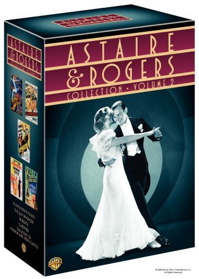
|
Warner DVD Flying Down to Rio, The Gay Divorcee, Roberta, Carefree, The Story of Vernon and Irene Castle Starring Fred Astaire and Ginger Rogers B&W 1:37 flat full frame Street Date October 24, 2006 59.98 the boxed set (keep cases) Available separately at 19.98; in addition, an Ultimate Set at 99.98 or an Amazon-Exclusive Partial Ultimate Set, 65.92. (Sets Explained below) Reviewed by Glenn Erickson |
This new release is available in multiple forms, so Savant is beginning this review with three paragraphs explaining the various offerings.
Warners has followed up last year's Astaire & Rogers Collection, which contained Top Hat, Follow the Fleet, Swing Time, Shall We Dance and The Barkleys of Broadway with the five new features in this new Astaire & Rogers Collection, Volume 2: Flying Down to Rio, The Gay Divorcee, Roberta, Carefree and The Story of Vernon and Irene Castle. All of these titles are available separately and come in standard Keep Cases.
With a clear eye on Christmas sales, Warners also offers all ten features in an Astaire & Rogers Ultimate Collector's Edition. This much pricier set comes with a bonus disc (not sold separately) containing the documentary Astaire and Rogers Partners in Rhythm, along with two folders of miniature pressbooks, poster artwork and stills on quality card stock. The discs in the Ultimate Collector's Edition are all on slim cases.
In a sympathetic gesture to consumers, Warners is offering a fair break for the owners of the original Collection that shouldn't have to completely re-buy it to get all the Ultimate extras: An Amazon Exclusive Astaire and Rogers Partial Ultimate Collector's Edition. It has all of the new contents -- the five Volume 2 features and the extras, with empty slim cases to accept last year's discs. The choices may be complicated, but Warners is showing courtesy uncommon in the DVD game.
Savant will be reviewing the five new features and the Ultimate Extras.
Last year's Astaire and Rogers Set took the middle four RKO features and a later MGM straggler. This second installment closes out the co-starring features with their three initial RKO efforts and their two last. The new titles include the first A&R pairing, the 'template film' for their biggest successes and at least one partial stumble, but every title has its share of romance, smart banter and superlative dancing.
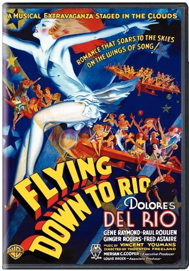
Flying Down to Rio
1933 / 89 min.
Starring Dolores del Rio, Gene Raymond, Raul Roulien; Ginger Rogers as Honey Hale; Fred Astaire as Fred Ayres.
Cinematography J. Roy Hunt
Art Direction Carroll Clark, Van Nest Polglase
Film Editor Jack Kitchin
Written by Lou Brock, Erwin Gelsey, H.W. Hanemann, Cyril Hume from a play by Anne Caldwell
Produced by Merian C. Cooper
Directed by Thornton Freeland
Flying Down to Rio would seem to be RKO's answer to Busby Berkeley's phenomenally successful series of musicals . Ginger Rogers hadn't received much more than featured specialty status over at Warner Bros.; Joan Blondell was equally sassy and Berkeley was more interested in geometric and architectural phantasmagorias than virtuoso singing and dancing. When Remember My Forgotten Man? needed a lusty soul singer, they called for Etta Moten. Both Ms. Moten and Ginger were imported to RKO for this pastiche that resembles a Bing Crosby picture grafted onto a series of nightclub performance short subjects. The nominal stars are Gene Raymond and Dolores Del Rio, who plays a Brazilian who speaks Spanish almost exclusively. Neither lead sings or dances and the main plot revolves around Raymond's play for Del Rio, with his friend Raul Roulien as a dapper third wheel.
RKO seems to have realized that the fun would come not from the low-wattage leads, but from the secondary singing and dancing team, Fred Astaire and Ginger Rogers, fifth and fourth-billed, respectively. He's a wacky musician and dancer in Raymond's band, and she's the visually sexy, verbally saucy lead singer. It's their show all the way and even the editing seems to know it.
Flying Down to Rio hits the Latin dance craze hard with The Carioca, a rhapsodic rhythm and melody piece that earns center stage for a full reel. It's sung and danced, and then danced and sung all over again. The singer in the 'tropical' costume is Etta Moten, and although her style is more Southern than South American, she sounds great. The lyrics imply that dancing The Carioca is akin to making love, as first foreheads touch, then other parts of the body. The Astaire-Rogers formula of elegant sex in motion in public is thus established. We also see Eric Blore in a small part; he would of course become a fixture in several of the A&R films. Other singers during the Carioca number are Alice Gentle and future Mrs. Marlon Brando, Movita (María Castañeda). Future kitchen appliance saleswoman Betty Furness is in there, along with Clarence Muse and Franklin Pangborn.
The script is pretty bad, with our gallant Americanos helping Del Rio's dad keep his nightclub open against the Rio de Janeiro version of gangsterism ... a trio of Greeks in top hats. Forbidden to entertain on the premises, the chorus girls join with Raul Roulien's biplanes to provide an aerial entertainment to the song Flying Down to Rio, the one with the campy "Rio by the Sea-O" lyrics. Berkeley would have simply stylized the impossible sight of showgirls strapped to the wings of airplanes and be done with it, but RKO uses sophisticated effects to give the appearance (to unsophisticated 1933 audiences, if they really existed) that the stunt is real. Therefore, we're given a scene with the girls being harnessed and tethered to the wings of the airplanes. Of course, the real fun is seeing the wind blow the showgirls' skimpy clothing to and fro. Tiny parachutes effect an aerial striptease of sorts, and the editors manage a few angles where those silky, wind-blown costumes look mighty insubstantial.
The story resolves itself without too much fuss, the movie pointedly ends on Astaire and Rogers' fun-loving secondary pair, and we all hum The Carioca for four days straight after the lights go up.
The extras on the individual discs come from each film's year of release ... MGM and Warners items. Flying Down to Rio has Beer and Pretzels, a popular early burlesque-style comedy starring Ted Healey and his Stooges. Healey really roughs them up. I Like Mountain Musicis a Hillbilly-themed cartoon. A fragment of an original trailer is here as well. Raul Roulien ended up at Fox, where he played opposite Edna May Oliver in a wacky Sci-Fi comedy about the last man on Earth called It's Great to Be Alive.
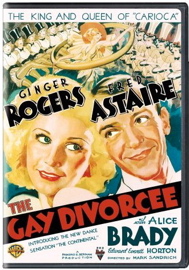
The Gay Divorcee
1934 / 107 min.
Starring Astaire and Rogers, Alice Brady, Edward Everett Horton
Cinematography David Abel
Art Direction Carroll Clark, Van Nest Polglase
Film Editor William Hamilton
Original Music Samuel Hoffenstein, Herb Magidson, Harry Revel, Kenneth Webb, Con Conrad, Cole Porter
Written by George Marion Jr., Dorothy Yost, Edward Kaufman from an unproduced play by J. Hartley Manners from the musical play Gay Divorce by Dwight Taylor adapted by Kenneth S. Webb, Samuel Hoffenstein
Produced by Pandro S. Berman
Directed by Mark Sandrich
With The Gay Divorcee RKO gets down to cases and invents the Astaire-Rogers vehicle in most basics. It seems to have taken three writers adapting a play from a musical adapted by two other writers to do the job. Fred ("Guy Holden") and Ginger ("Mimi Glossop") meet cute when he rips her dress to free it from a steamer trunk. They each have a comedy sidekick in tow: Edward Everett Horton with a funny name ("Pinky") and Alice Brady as a ditzy aunt who loves to marry so she can get divorced again.
Then there's the Big Misunderstanding plot engine: Mimi needs a divorce from William Austin's stubborn cad, so Pinky sets her up with a professional 'co-respondent' Rodolfo Tonetti (Erik Rhodes), the first of several quasi-gigolo lounge lizards in these pictures. Mimi gets the notion that professional dancer Guy is her designated divorce operative and the three-way confusion begins.
Astaire and Rogers' binary charm is immediately evident. Each has a novelty number and then we have Guy's lovesick pursuit, which of course breaks off just before Mimi becomes interested. Music eventually brings them together in an extended dance number almost twice as long as The Carioca. The Continental became the first Oscar winner for Best Song. It's broken up into several sections. Mimi and Guy use a trick with a paper doll in a phonograph to keep Rodolfo busy while they go downstairs to make musical history. Astaire, Rogers and Lillian Miles provide singing voices in between bouts of ballroom dancing.
RKO's musical numbers stand out for Van Nest Polglase's shimmering, multi-leveled Art Deco sets, and for their cookie-cutter approach to mass dance numbers. A good 100 dancers take to the floor in Flying Down to Rio and The Gay Divorcee, and go through plenty of Busby Berkeley-style gyrations -- except that many of the shots are connected with dissolves, with the dancers in extremely different positions. There is some coordinated choreography but many dissolves simply stitch together mass dancing activity that might have been performed to a metronome.
The biggest new delight beyond the dance floor is the witty script that defines the characters with clever jokes that don't date. There are few topical references and only a hint here or there of dated racial or social gaffes ... I'm hard pressed to remember any, and this was when almost every Hollywood screenplay had slap-happy patter like, "That's mighty white of ya!" Astaire and Rogers are cute, funny and thoroughly sentimental under their sophisticated jokes about divorce. They wear evening clothes that verge on Utopian fantasy. They're so obviously made for each other that we're behind them all the way. Their dancing skills represent a shared ability to fly, and they're birds of a feather.
Edward Everett Horton and Alice Brady provide plenty of laughs, as does Eric Blore's unflappable waiter. Erik Rhodes is afforded some measure of respect, even when a phone call to his wife establishes that he's being cuckolded and is the only one that doesn't know it. Look in the dance number and you'll see 17 year-old Betty Grable. She gets last billing.
The The Gay Divorcee extras start with two Technicolor musical shows. Show Kids features a battalion of moppets and 'youths' performing adult-style variety material; as few of them should be able to really understand what they're killing themselves for under the hot lights (Mom 'n' Dad gotta eat) the whole enterprise is a little creepy. The color, which is clearly still experimental, is weird as well. Star Night at the Cocoanut Grove is another variety piece with 'star' cameos cut in to the proceedings. The shots in the Grove (or an MGM reconstruction) range from gloomy-dark to quite attractive. Shake Your Powder Puff is yet another grotesque early cartoon, this time from Friz Freleng and Leon Schlesinger. A radio promo for The Gay Divorcee is included, along with an original trailer.
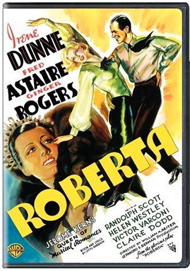
Roberta
1935 / 106 min.
Starring Irene Dunne, Astaire and Rogers, Randolph Scott, Helen Westley, Victor Varconi, Claire Dodd
Cinematography Edward Cronjager
Art Direction Van Nest Polglase
Film Editor William Hamilton
Written by Sam Mintz, Jane Murfin, Allan Scott, Glenn Tryon from the play by Otto A. Harbach from the novel Gowns by Roberta by Alice Duer Miller
Produced by Pandro S. Berman
Directed by William A. Seiter
Roberta sounds promising but turns out to be a disappointment for Astaire & Rogers fans; it appears to be an attempt to shoehorn the dancing pair into a play that doesn't really fit their style. It's more than the fact that they again share center stage with another romantic pair. The play klunks along with oddly sentimental and even downbeat touches. Randolph Scott simply doesn't carry the comedy or the romance with top-billed Irene Dunne, and Irene ends up as sort of a wilting flower in a movie that doesn't want to concentrate on her character. Roberta has its own classic song and plenty of amusing comedy, but it's the most confused of the Astaire and Rogers collaborations.
Roberta doesn't have an official funeral scene, but it comes close. Irene Dunne's soulful presence was killer stuff in Showboat and even Sweet Adeline but her teary-eyed solo singing bouts (always in a static close-up) tend to cramp this film's style. Astaire and Rogers must struggle for attention amid a lot of distracting content. The odd White Russian subplot gives Stephanie a mysterious Prince as a consort (Victor Varconi); she ends up pulling a veritable Anastasia act that amounts to little beyond a tiara and a forlorn attitude. Clearly there was a deep sympathy in Hollywood to restore the monarchy to Russia, but I confess I don't know it means when a musical is weighted down with melancholy Muscovites. Claire Dodd plays Kent's old girlfriend but is so obviously a villain that her subplot also seems a waste of time.
The movie also goes in for a lot of gay-themed humor. Randolph Scott, one of the handsomest men in Hollywood, starts off with a bird's nest for a haircut and is given a 'make over' (that exact term) by his Aunt. He tries to take the fashion racket seriously but it's assumed that one must be female or 'that way' to function in the business. In addition to a few tasteful rolls of the eye, Astaire's Huck character asserts his masculinity by showing his discomfort when he tries to keep the boutique going single-handedly. Huck complains that he's been in the salon so long, his voice is changing.
Roberta gets back on the rails with periodic doses of music and dancing. Huck and Mimi get together without much fuss or conflict, so we have to be content with great songs like I Won't Dance. The featured tune is Kern and Harbach's Smoke Gets In Your Eyes, which doesn't do too well sung in operatic terms by Dunne -- it's just plain sad. But it provides a soothing background for the expected slow ballroom dance.
One odd scene is a French lesson in which Huck and Kent harass the instructor, an idea that seems to have been adapted for the later Singin' in the Rain. The film culminates in an impressive fashion show scene and a comedy finish on a fancy elevator that isn't very funny. Earlier in the film Dunne warns Scott not to attempt to exit the elevator when it's stuck three feet off-floor. The film's musical spell is briefly broken by the grim thought that the film might be setting us up for some one to be cut in half by an elevator. An odd movie.
Lucille Ball is among the many fashion models, and William Frawley is a bartender but is not named Fred Mertz. A featured comedian in Astaire's band is Candy Candido, who does vocal tricks and comic dance steps. Candido later specialized in cartoon voices, starting with Disney's '53 Peter Pan.
The extras on Roberta include yet another outdoor variety Technicolor experiment, Starlit Days at the Lido. The guest stars pointed out by the emcee this time include sports figures. Future Jiminy Cricket voice Cliff Edwards does one of his falsetto 'scat' songs while a female magician pulls lit cigarettes out of his pockets and his banjo. Male stars enjoying the show together are invariably composed with flower arrangements between them.
The cartoon The Calico Dragon is an odd two-color (bluish and reddish) dream world of quilted landscapes and stuffed rag-doll characters. The Dragon itself has three heads and resembles a Scottish Ghidorah. The Trailer for Roberta is accompanied by another radio promo.
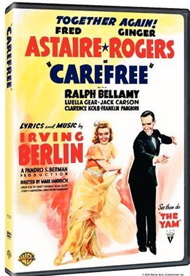
Carefree
1938 / 83 min.
Starring Astaire and Rogers, Ralph Bellamy, Luella Gear, Jack Carson, Clarence Kolb, Franklin Pangborn
Cinematography Robert de Grasse
Art Direction Van Nest Polglase
Film Editor William Hamilton
Written by Marian Ainslee, Guy Endore, Dudley Nichols, Ernest Pagano, Allan Scott, Hagar Wilde
Produced by Pandro S. Berman
Directed by Mark Sandrich
Skip ahead five masterpieces to 1938 and we get to Carefree, a top-form Astaire-Rogers romp that bears the unmistakable mark of the screwball comedy style. We can tell it's a screwball comedy, as poor Ralph Bellamy is on hand to play the chump who loses the girl. Psychiatry gets a healthy ribbing while hypnosis seems to reveal a particularly spacey unconscious within Ginger's character -- she's either a romantic dreamer or a mischievous imp, as she'd much later reprise in Howard Hawks' Monkey Business.
This time out an exceptionally clever script keeps the show afloat even when Astaire and Rogers aren't front and center, and Carefree becomes a hilarious experience. Set pieces include a nicely motivated slow-motion dream dance and a comic song called The Yam that shows a growing jitterbug influence. Fred has a knockout number in which he simply hits about 30 golf balls in a row to some dance music, a trick that Katherine Hepburn revisited in her Pat and Mike.
The psychiatric theme is more than voodoo nonsense and in fact is quite relevant. Amanda Cooper balks at marriage. Since the prospective groom considers himself perfect, the fault must be in her brain, so off to the shrink she goes. The plot continually compares romantic confusion with mental dizzyness. It also suggests that Tony's influence frees Amanda to do what she really wants, like break windows in anarchistic glee. He also turns her into a potentially murderous killer zombie when she starts slinging a 12-gauge around the skeet range. With Franklin Pangborn running for cover, the whole thing is funny instead of in bad taste.
The supporting cast is more charming than manic, which helps keep the comedy focused on an odd level of realism. The main comic foil is Luella Gear's Aunt Cora, who thinks that Bellamy shoots not 'skeet' but 'scat' and also gets the notion that Jack Carson's male nurse is sweet on her. Clarence Kolb plays a stuffy judge who turns a stern eye toward all of Tony and Amanda's inexplicable inconsistencies. The action on the dance floor emphasizes fun over glamour and the movie ends with one of the best wedding day switcheroo scenes ever ... and a great final shot.
The B&W short subject is a terrific piece called Public Jitterbug #1 sadly represented by what must be a rare surviving 16mm print with marginal sound. Government Agent Hal Leroy is dispatched to arrest the biggest jitterbug in the country but is of course charmed when he meets up with Betty Hutton's singing dynamo! It's not Betty's first film appearance, but she's only 16 or 17 years old.
The color cartoon September in the Rain has an extended Al Jolson blackface and "Mammy"- type caricature and is given one of Warners' PC disclaimers. I remember this one showing constantly on TV in the early 60s. Carefree has no trailer, boo hoo.
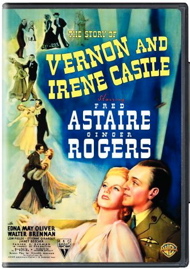
The Story of Vernon and Irene Castle
1939 / 93 min.
Starring
Cinematography Robert de Grasse
Art Direction Van Nest Polglase
Film Editor William Hamilton
Written by Oscar Hammerstein II, Dorothy Yost, Richard Sherman from stories by Irene Castle
Produced by George Haight
Directed by H.C. Potter
As if to say 'now for something completely different,' The Story of Vernon and Irene Castle is a heartfelt musical biography that succeeds by avoiding the maudlin excesses that would mar later bios of greats like Gershwin and Cole Porter. After eight movies together Rogers and Astaire were surely looking for new avenues. She clearly was after a more varied career that included dramatic roles, and in a few years he'd consider retiring. This film jumps back to a 'bygone' age of simpler entertainment to tell the story of a phenomenally successful husband and wife pair of dancers. Vernon and Irene Castle brought ballroom dancing out of a few urban clubs and essentially 'gave it to the masses,' becoming cultural superstars in the process
The Story of Vernon and Irene Castle works quite well, thanks to its makers' good taste and good sense. Vernon and Irene are introduced as 'greats from not so long ago' even though the world had changed tremendously in just 25 years. It was much later before Hollywood established any kind of general attitude toward anachronisms, and this show is surprisingly authentic in presenting exhibition dancing as it was performed between 1910 and 1918 or so. Irene and Vernon don't exhibit any swing or jitterbug moves, and even tone down their classical ballet-type work, giving us a souvenir of what made them famous in their time. Probably the most relevant scene is when they demonstrate their own custom step in a fancy Paris bistro ... the other couples take to the dance floor and immediately imitate them. On such popular foundations are great legends built.
The film has a long section of romance and work struggles that works because we want this pair to be successful. Vernon starts as a clown and Irene as an enthusiastic schoolgirl, so every disappointment brings some tension. As we know that they'll succeed, our personal commitment to the actors must be what makes the difference. The Story of Vernon and Irene Castle must really have had an aspect of "the story of Astaire and Rogers" -- and the cumulative audience identification with the pair carried a powerful emotional charge. The filmmakers respected this audience connection and didn't exploit it by making the film more dramatically wrenching, which for Hollywood shows uncommon restraint. The eventual sad ending is carefully telegraphed and the audience pre-conditioned.
Ginger Rogers is the big winner, as her character goes from a gushing teenager to a grieving widow. Astaire is more of a straight man in this more serious film; the military ending must have had a topical relevance to the tensions of 1939, and there aren't many 'carefree' touches. There's no marriage ceremony but the pair's rehearsal vow to become dancers together (in unison: "It's our idea.") might as well be a wedding vow. The movie really is about the ending of the screen's greatest partnership. Times change and people need to move on. Rogers' final observance of the 'ghost dancers' is an obvious metaphor for the end of the RKO Astaire-Rogers films.
The Story of Vernon and Irene Castle maintains a subdued manner that contrasts well with the "gee whiz" hysterics in the Rooney-Garland films over at MGM. Astaire does a soft shoe with an 'amateur' hoofer at a train station, a rather fat guy who is not used as an object of humiliation. Show Biz people are not 'bigger than life', neither the vain headliner that stands Vernon up nor his comedy star boss (Lew Fields, playing himself) nor the French sharpies that entice the performers to come to Paris. Edna May Oliver and Walter Brennan provide straight support and have few opportunities to show off or act cute. The pattern is simple: Success should be followed by a chance to relax and begin a 'normal' life together, but life doesn't always cooperate. Vernon's fate is a reminder that reality, like the big war approaching, is going to burst the bubble of even the glamorous Astaire-Rogers teaming. The party's almost over.
The movie has one truly remarkable optical shot that combines an aerial take of the pair dancing on a giant map of the United States with many inset groups of smaller people springing up as they 'cross the country.' As the camera is in motion throughout most of the take, how the shot was accomplished is not easy to figure out.
The extras on The Story of Vernon and Irene Castle are fairly interesting. Puss Gets the Boot is a Technicolor cartoon that may be the beginning of Tom and Jerry, except the cat is named Jasper and the mouse has no name at all. It's given a PC disclaimer card for the 'Mammy' character that enters to clean up Jasper's mess. Happily Buried is a bizarre musical short about a merger between two waffle companies and a marriage between their presidents. It starts out as an operetta and then goes weird when the male merge-ee picks up an Indian swami who helps him publicize his waffle company through the stunt of burying himself alive. People walk past his resting place behind glass as if they were visiting Lenin's tomb. The conflict is eventually resolved when the guy rudely ruins the girl's promotional show, at which point she decides that she needs to drop out of business and become his housewife. This is the film that really needs the PC disclaimer card, as its attitude to the Indian swami -- he instantly wants to be our hero's eternal slave -- is pretty offensive ... not to mention the appalling attitude toward the wife's career plans!
Astaire & Rogers Collection, Volume 2 finishes out the set in style. The quality of the transfers is in general actually better than in Volume 1, probably because most of the films saw less duplication over the years. The Story of Vernon and Irene Castle is near perfect; we're told that it didn't do as well as the others. Flying Down to Rio has always been a blurry 16mm mess; I remember seeing TV prints with half the frame out of focus. Here it looks great, with only the opticals suffering from heavier grain. In the fast-cut Carioca sequence the telecine transfer machine also has trouble with weakened splices, resulting in some odd frame jumps, but nothing serious. The audio tracks are all good, but some patches are less clear than others, as if the only optical tracks available for some reels were dupes. Turner and Warner's audio restoration smooths out most of the anomalies. In The Gay Divorcee one song purposely alternates quiet and louder passages, and the restoration seems to have exaggerated the contrast in volume.
The 77-minute Sparkhill docu on the extra disc starts out on a bad foot, with a bland discussion of the Depression, but soon organizes a huge quantity of material into a coherent shape: Full bios on Astaire and Rogers, a run-down of their careers together and separately, RKO politics and behind-the-scenes stories of collaborators, friends and associations. New interviews and Turner library interviews are inter-cut with exceptionally good archival footage, even home movies, to fill in all possible angles. Peter Bogdanovich leads a long list of interviewees, many of which worked with the pair.
Two more folders contain miniaturized stills and premiere press book reproductions. Film fans have been grousing about the non-availability of the full Astaire-Rogers catalog since the beginning of laserdiscs, and Warners' deluxe sets have finally polished them up for a new audience.
On a scale of Excellent, Good, Fair, and Poor,
|
Flying Down to Rio rates:
Movie: Very Good Video: Very Good Sound: Very Good |
The Gay Divorcee rates:
Movie: Excellent Video: Excellent Sound: Excellent |
|
Roberta rates:
Movie: Very Good Video: Excellent Sound: Excellent |
Carefree rates:
Movie: Excellent Video: Excellent Sound: Excellent |
|
The Story of Vernon and Irene Castle rates:
Movie: Excellent Video: Excellent Sound: Excellent |
Packaging: five keep cases in card box Reviewed: October 28, 2006 |
Review Staff | About DVD Talk | Newsletter Subscribe | Join DVD Talk Forum
Copyright © MH Sub I, LLC dba Internet Brands. | Privacy Policy | Terms of Use
|
| Release List | Reviews | Price Search | Shop | SUBSCRIBE | Forum | DVD Giveaways | Blu-Ray/ HD DVD | Advertise |





